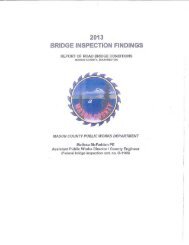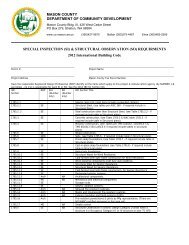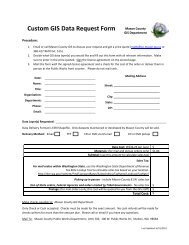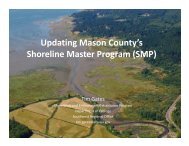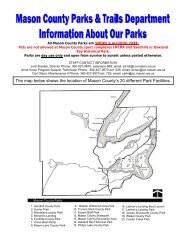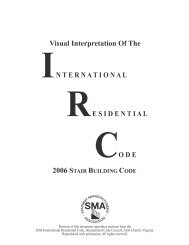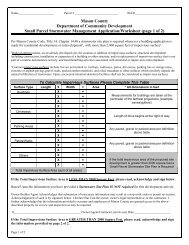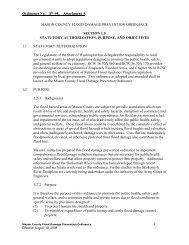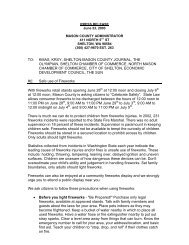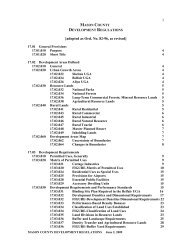Watershed Management Plan - Mason County
Watershed Management Plan - Mason County
Watershed Management Plan - Mason County
Create successful ePaper yourself
Turn your PDF publications into a flip-book with our unique Google optimized e-Paper software.
Appendix<br />
C Key Issues and Options – Water Quality<br />
for maintenance of roadside ditches, including regular inspections and<br />
cleaning, planting of vegetation, and examination of culverts for evidence of<br />
scour. The manual also recommends – but does not require – that<br />
jurisdictions install bioswales and filter strips to treat runoff from roads,<br />
and to use engineered topsoils when needed to establish and maintain<br />
roadside vegetation. Bioswales are ditches ranging from two to ten feet in<br />
width that use plants and topsoil to filter pollutants from stormwater. A<br />
filter strip is a flat area that performs the same functions as a bioswale.<br />
Filter strips consist of a narrow band of gravel that borders a roadway and a<br />
wider swath of vegetation adjacent to the gravel (Washington Department<br />
of Ecology, 2001).<br />
The <strong>Plan</strong>ning Unit could request that the Washington Department of<br />
Transportation implement these recommended best management practices<br />
for treating stormwater runoff from highways, particularly when highway<br />
repairs are conducted.<br />
Option 51.<br />
Adopt the most current Stormwater <strong>Management</strong><br />
Manual for Western Washington or equivalent<br />
manual<br />
The Puget Sound Water Quality Action Team’s Puget Sound Water Quality<br />
<strong>Management</strong> <strong>Plan</strong> (2000) calls for cities and counties to adopt a stormwater<br />
management manual to guide their water quality efforts. Specifically, the<br />
<strong>Management</strong> <strong>Plan</strong> encourages local governments to adopt the Department of<br />
Ecology’s Stormwater <strong>Management</strong> Manual for Western Washington. The most<br />
recent version of the manual was released in early 2005 (Washington<br />
Department of Ecology, 2005b).<br />
Should a local government opt not to adopt Ecology’s manual, the<br />
<strong>Management</strong> <strong>Plan</strong> recommends adopting an “equivalent” manual (Puget<br />
Sound Water Quality Action Team, 2000). Jurisdictions must submit their<br />
chosen manuals to Ecology for review and approval. Other manuals<br />
developed in Washington State include the 2005 King <strong>County</strong> Surface Water<br />
Design Manual (King <strong>County</strong> Water and Land Resources Division, 2005),<br />
and the Stormwater Manual for Eastern Washington, published in 2004<br />
(Washington Department of Ecology, 2005c). Although King <strong>County</strong> is<br />
more urbanized than <strong>Mason</strong> and Jefferson Counties, significant portions of<br />
the county are still rural, with agriculture and forestry as primary land uses.<br />
Therefore, the King <strong>County</strong> manual may be useful in WRIA 16. The<br />
Eastern Washington manual likely is not appropriate for WRIA 16 because<br />
of climatic differences.<br />
The US EPA’s national best management practices for NPDES Stormwater<br />
Phase II can be downloaded from their website 14 . However, the EPA<br />
intends that these best management practices serve as guidance for local<br />
14 http://cfpub.epa.gov/npdes/stormwater/menuofbmps/bmp_files.cfm<br />
page 120 Final <strong>Plan</strong> for <strong>County</strong> Adoption – May 11, 2006



